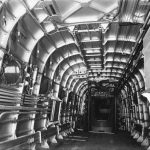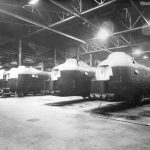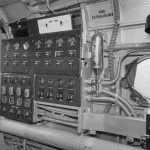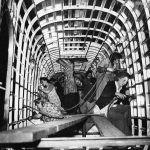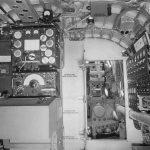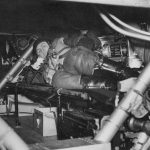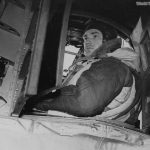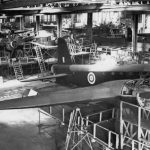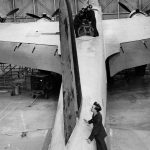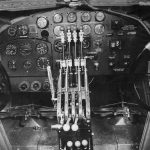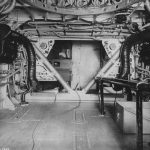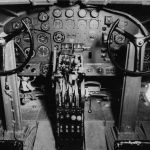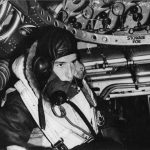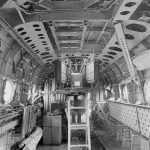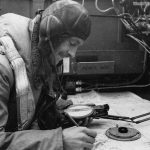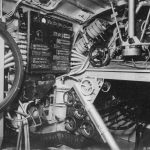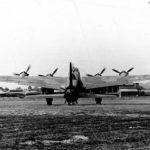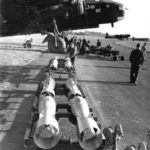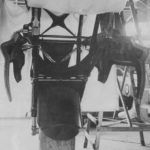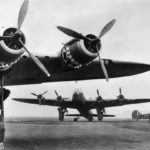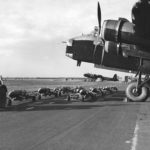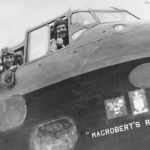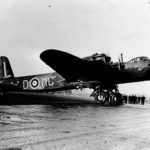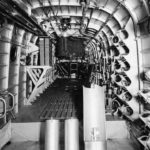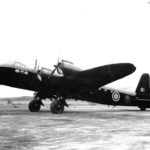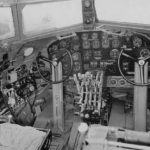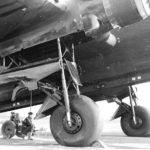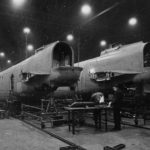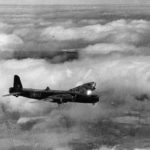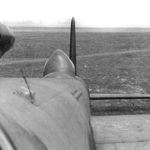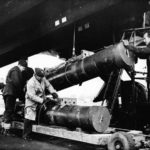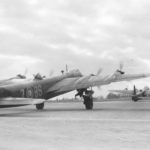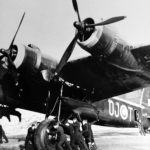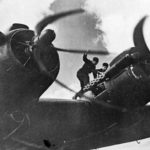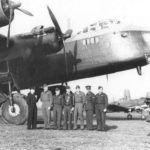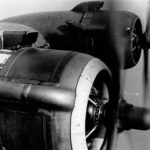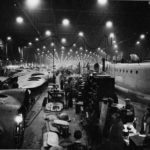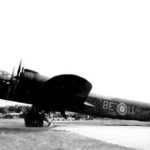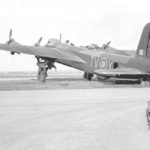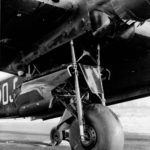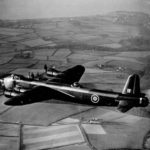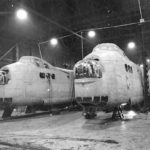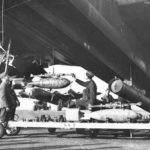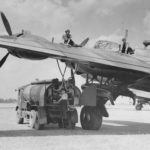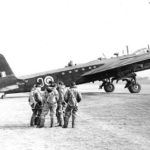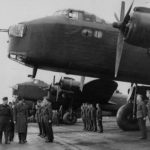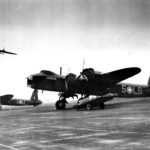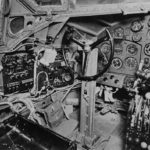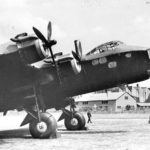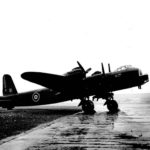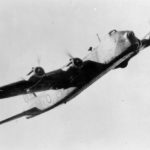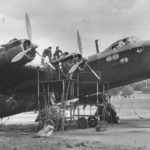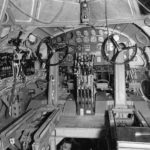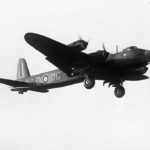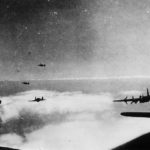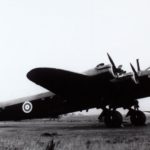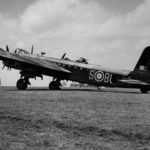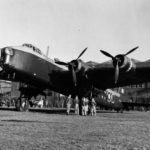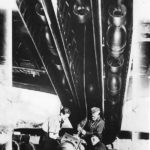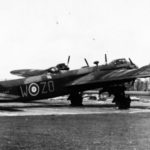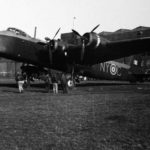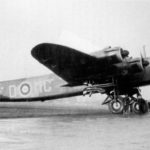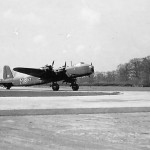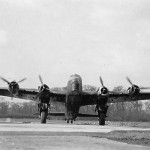Stirling tail wheels
Stirling ventral turret
Fuselages minus tailplane, turrets and fin
Stirling under construction
Wing was constructed around a pair of main spars, covered with light alloy sheeting and flush-riveted
Stirling interior
Female technician works on an engine nacelle of a Stirling at Longbridge in January 1942
Stirling cockpit
Stirling engineers instrument board
Room of the flight engineer
Rear gunner turret
Women made up the majority of the workforce that built the Stirlings so desperately needed by Bomber Command in the early days of the war.
Navigator’s position on the port side of the bomber
Wireless operator’s station (left)
Stirling Belfast
Bunk of a bomber
Front Gunner
Bomb aimer station with Mk XIV bomb sight
Stirling production
Access to the Nash & Thompson FN.7A dorsal turret
Stirling production Belfast 1942
Bomber is inspected before being painted and sent back to an operational unit, 1942.
Stirling Flight Controls
Stirling interior
One of the workers at the Austin Motors factory at Longbridge in January 1942
Bomber is inspected before being painted
Stirling engineers controls
Central compartment of the Stirling with the central bomb bay below and the oxygen bottle stowage area above
Stirling cockpit
General view of the cockpit area
Front Gunner
An interior view looking aft from behind the centre section.
The navigator’s table was situated behind and slightly below the pilot’s seat, and consisted of a table for map-reading and basic instrumentation.
Stirling Bomber Production
Stirling engineers controls
Stirling Mk I rear view
Stirling Mk I N6069 of 1651 Conversion Unit
Stirlings of the 1651 Conversion Unit in formation
Engineers work on the undercarriage at Longbridge
Bombs sit ready to load on Stirling MG-G of No. 7 Squadron RAF October 1941
Stirling Mk I front view
German Stirling on the ground
RAF ground crew loading bombs onto a Stirling bomber 1942 2
Stirling rear view 2
Stirling undercarriage, rear view 2
Stirling Mk I W7508 fuselage under construction at Longbridge
Stirlings and Avro Anson of No. 48 Squadron RAF
Stirling Mk I of No. 7 Squadron RAF October 1941
Stirling I OJ-B W7455 of No. 149 Squadron RAF
The RAF bomber command crew, pictured loading bombs onto a Stirling
Short S.31/M4 prototype in flight
Stirling Mk I MG-A N6075 of No. 7 Squadron RAF
15 Squadron xrew with Stirling N6086 “MacRobert’s Reply” November 1941
Stirling Mk I turrets
Stirling undercarriage 3
N3641 MG-D of No. 7 Squadron RAF 1940
Stirling fuselage
Stirling Mk III 2
Stirling in hangar 1942
Stirling cockpit 2
Stirling main gear
Stirling Mk I BF382 BU-Q of No. 214 Squadron at RAF Stradishall
Stirling tail section under construction at Austin factory
Stirling Mk I W7459 of No. 1651 Conversion Unit RAF 3
Stirling Mk I of No. 7 Squadron RAF October 1941 2
Stirling bomber under construction at Longbridge.
Stirling MG-S W7446 bomber crew prepare for flight October 1941
Stirling Mk I HA-Q of No. 218 (Gold Coast) Squadron RAF
Stirling rear 2
Stirling Wireless Operator Control Station
Ground crews loading mines onto a Stirling bomber
Stirling BS-Z of 1651 HCU
Stirling Mk I code OJ-T of No. 149 Squadron RAF
Stirling Mk III of No. 90 Squadron RAF warming up for a mission
Stirling Mk I crew
Stirling Mk I engines
Stirling Mk I E
Stirling assembly line
Glider tug Stirling Mk IV 8E-U of No. 295 Squadron RAF
Stirling Mk III TV-Y of No. 1660 Conversion Unit RAF with H2S radar
Stirling of No. 149 Squadron RAF main gear
Factory fresh Stirling Mk III BF509
Stirling fuselages at Austin plant
Ground crewman hoist bomb 2
Stirling Mk V PJ897 transport version
Stirling Hercules XI engines
AEC 854 Matador refueling a Stirling at Waterbeach in 1943
Stirling bomb aimer position
Ground crewman hoist bomb 1942
Stirling Mk I W7459 of No. 1651 Conversion Unit RAF before training flight
Stirling Mk III. Duke of Gloucester visit Squadron in 1943
Stirling Mk III 3
Stirling Mk I N6069 of 1651 Conversion Unit in flight 2
Stirling N3669 1943
Stirlings LS-S. LS-G and LS-T of 15 Squadron RAF
Stirling at Empire Central Flying School
Instrument panel of the Stirling
Stirling Mk I 2
Stirling UG-O of No. 1654 HCU
Stirling Mk IV on the ground
Stirling Mk I during maintenance
Stirling of No. 149 Squadron RAF 1942
MG-D N3641 of 7 Sqn in flight
Bomber Command Crew with Stirling MG-S W7446 October 1941
Stirling Mk I W7459 of No. 1651 Conversion Unit RAF 2
Stirling crew, grounf personel and bombs
Early Stirling Mk I N3638 at Sydenham
Groundcrew service the Bristol Hercules engines.
Stirling cockpit 3
Stirling MG-D N3641 landing 1941
Bristol Hercules engines
No. 15 Squadron RAF Stirlings Mk I and Hurricane escorts
Stirling bomber with crew
Stirling Mk I N6090
Stirling Mk I W7577 code BU-S of No. 214 Squadron RAF
Stirling NY-C of No. 1665 Conversion Unit RAF 2
No. 218 (Gold Coast) Squadron RAF Stirling bombing up at Downham Market 1942
RAF pilots seated at controls of Short Stirling ’41
Short Stirling NY-C of No. 1665 Heavy Conversion Unit RAF 3
Bombing up Stirling at RAF Station in England 1941
Stirling Mk III ZO-W LK403 of No. 196 Squadron RAF
Short Stirling bombers on production line at factory in England 42
Short Stirling code NY-C of No. 1665 Conversion Unit RAF
N3641 MG-D of No. 7 Squadron RAF at Oakington
Stirling of No. 1651 Conversion Unit RAF in flgiht
Short Stirling coded XT-M of No. 1657 H.C.U. RAF
Short Stirling W7455 OJ-B of No.149 Squadron RAF Bomber Command at Mildenhall 1942
Short Stirling tail with D-Day stripes
Short Stirling code XT-M of No. 1657 Heavy Conversion Unit RAF
Stirling Mk IV ZO-B of No. 196 Squadron RAF
RAF bomber command bomber Stirling Mk III
Short Stirlings Towing Horsa Gliders Across Rhine 1945
Short Stirling Bomber code XT-M of No. 1657 Heavy Conversion Unit RAF
1st Airborne Division soldiers and Stirling Bombers Operation Doomsday Norway 1945
N3705 of 7 Sqn made a forced landing at Gorinchem in Holland
Short Stirling Mk I of No. 7 Squadron RAF N3643 MG-G 1941
Stirling Mk IV code 7T-P of No. 196 Squadron RAF Transport Command
Short Stirling code XT-M of No. 1657 HCU RAF 2
The Stirling was a World War II heavy bomber design built by Short Brothers. It was the first British design meant to use four engines from the outset, an otherwise successful experiment that was hampered by a number of odd design requirements. In the end it would be relegated to second-line duties, while four-engine conversions of earlier twin-engine designs took over its role.
Through the 1930’s the Royal Air Force was interested primarily in twin engine bombers. These designs put limited demands on engine production and maintenance, both of which were already stretched with the introduction of so many new types into service. However. the limitations in terms of power were so serious that they invested heavily in development of huge engines in the 2,000 horsepower class in order to improve performance. Meanwhile the US and USSR were developing bombers with four smaller engines instead, which proved to have excellent range and fair lifting capacity. So in 1936 the RAF decided to try their hand at the four engine bomber as well.
It wasn’t entirely clear what they wanted in an aircraft, and the resulting Specification B.12/36 was an odd mix of features. In addition to a 14,000 lb (6,350 kg) bombload carried to a range of 3,000 miles (4,800 km)(incredibly demanding for the era), the aircraft should also be able to be used as a troop transport for 100 soldiers. The idea was that it would fly troops to far corners of the British Empire, and then support them with bombing. To help with this task as well as ease production, it needed to be able to be broken down into parts for transport by train. Since it could be operating from limited airfields, it needed to lift off from a 500 ft (150 m) runway and able to clear 50 ft (15 m) trees at the end, a specification most small aircraft would have a problem with today. In addition, so it would fit into existing hangars, the wingspan should not exceed 100 ft (30 m). This last requirement was particularly odd, as the most common Type C hangar opened to over 125 ft (38 m).
Shorts was one of eleven designs returned in response to the requirements, but were likely the only company that could have realistically started production in a short time. They had several four-engine flying boat designs of the needed size, and created their S.29 design by basically removing the lower deck and boat hull of their S.25 Sunderland. The S.29 was largely identical otherwise; the wings and controls were the same, construction was identical, and it even retained the slight upward bend at the rear of the fuselage, originally intended to keep the Sunderland’s tail clear of sea spray.
Shorts managed to persuade the RAF to dismiss most of its unrealistic design goals when they saw that the S.29 would be an excellent bomber. But on one point the RAF stood firm: the S.29 used the Sunderland’s 114 ft (35 m) wing, and they demanded it be reduced to less than 100 ft (30 m). In order to get the needed lift, the resulting redesigned wing was thickened and reshaped.
Shorts first constructed a half scale version as the S.31, which flew in September 1938. Everyone was happy with the design in general, with the exception of the takeoff run was thought too long. Fixing this required the angle of the wing to be increased for takeoff, meaning the aircraft would be flying nose down while cruising. Instead, Shorts lengthened the landing gear to tilt the nose up more on the runway, leading to its spindly gear.
The first S.29, now known as the Stirling, took to the air in May 1939 with four Bristol Hercules engines. Upon landing one of the brakes locked, causing it to skew off the runway and the landing gear collapsed. A redesign added a much stronger and heavier set of gear on the second prototype. On its first mission two months later one of the engines failed on take-off, but the plane landed easily. From then on the record improved and service production started in August 1940 at Shorts’ factory. Several were destroyed during Battle of Britain raids, and operational status wasn’t reached until January 1941.
Although it wasn’t as large as the US and Soviet experimental designs, the Stirling had considerably more power and far better payload/range than anything then flying. The massive 17,000 lb (7,700 kg) bombload put it in a class of its own, double that of any other bomber. In fact it was larger than the Avro Lancaster and Handley-Page Halifax which would eventually replace it, but both of these were originally designed to have twin engines.
The design mounted nose and tail turrets (the later was notable for the wide angles it could point its guns), and included a retractable ventral turret just behind the bomb bay that was fired by remote control. This proved to be almost useless due to the limited visibility through the sighting system, with the added distraction that the turret tended to drop when taxing over bumps and hit the ground. It was removed almost from the start, to be replaced by a new dorsal turret instead. This turret had its own problems: it had a metal back with an escape hatch in it, but it turned out to be almost impossible to use. The later Stirling Mk.III instead used a fully glazed turret that removed the hatch, and had more room and an improved view.
The first few Mk.I’s received the Hercules II, but the majority received the 1,500 hp (1.100 kW) Hercules XI. The Mk.III was similar with the exception of the new dorsal turret and the improved 1,635 hp (1.2 MW) Hercules VI or XVI engines, which improved maximum speed from 255 to 270 mph (410 to 435 km/h).
The Stirling proved to be an excellent design and pilots were delighted to discover that it could outturn the Junkers Ju 88 and Messerschmitt Bf 110 nightfighters they faced: a side effect of that thick wing. Another side effect of the thick wing was poor altitude performance, and many missions were flown as low as 12,000 ft (4,000 m). This made the plane particularly difficult to use in many scenarios, notably if they were attacking Italy and had to fly over the Alps. When operated along with other RAF bombers flying at higher altitudes, the Luftwaffe ignored the latter and concentrated on the low-flying Stirlings. Within five months of being introduced, 67 out of the 84 aircraft delivered had been lost to enemy action or written off after crashes.
In addition the Stirling’s huge bomb load was only able to be delivered at short ranges. On typical missions into Germany or Italy a smaller 3,500 lb (1,600 kg) load was carried, consisting of seven 500 lb (230 kg) bombs. This was the sort of load being carried by the RAF’s medium bombers such as the Vickers Wellington, and by 1944 by the deHavilland Mosquito. Perhaps the biggest problem with the design was that the bomb bay had dividers running down the middle, limiting it to carrying 500 lb (230 kg) bombs at the largest. As the RAF started using the 4000 lb (1,800 kg) ‘cookies’, and even larger ‘specials’, the Stirling became less useful to them.
By March of 1943 the Stirlings were already being phased out of bomber duty, seeing more use for dropping mines outside German ports, and dropping spies deep behind enemy lines at night (through the now unused ventral turret ring). In 1944 a new Mk.IV series was built without the nose and dorsal turrets for towing gliders and dropping paratroops, and the otherwise similar Mk.V removed the tail turret as well.
Total production : 2383.
Serials
Mk I
N3635-N3684, N3700-N3729, N3750-N3769, N6000-N6049, N6065-N6104, N6120-N6129, R9141-R9170, R9184-R9203, R9241-R9290, R9295-R9334 (R9188 converted to Mk II and then Mk III) W7426-W7475, W7500-W7539, W7560-W7589, W7610-W7639 (W7432 and W7455 Mk III conversions) BF309-BF358, BF372-BF416, BF434-BF454, BK592-BK628, BK644-BK650 (BK648 and BK649 Mk III prototypes) DJ972-DJ977, EF327-EF369, EF384-EF400, EF413
Mk III
BF455-BF483, BF500-BF534, BF561-BF580, BK651-BK652, BK686-BK727, BK759-BK784, BK798-BK818, EE871 -EE918, EE937-EE975, EF114-EF163, EF177-EF217, EF231-EF277, EF289-EF316 (some converted to Mk IV) EF401-EF412, EF425-EF470, EF488-EF518 (some conversions to Mk IV) EH875-EH909, EH921-EH961, EH977-EH996, EJ104-EJ127, LJ440-LJ483, LJ501 -LJ544, LJ557-LJ596, LJ611-LJ653, LJ667-LJ670 (some converted to Mk IV; LJ512 Mk IV prototype, LJ530 Mk V prototype) LK375-LK411, LK425-LK466, LK479-LK521, LK535-LK576, LK589-LK624 (some converted to Mk IV) MZ260-MZ264
Mk IV
EF317-EF323, LJ810-LJ851, LJ864-LJ899, LJ913-LJ956, LJ969-LJ999, LK114-LK156, LK169-LK211, LK226-LK257, LK270-LK313, LK326-LK370, PK225-PK237, PW255-PW266, PW384-PW425, PW438-PW465, TS261-TS266
Mk V
PJ878-PJ923, PJ935-PJ959, PJ971-PJ999, PK115-PK118, PK171-PK186
Source
Aeroplane August 2002
Francis K. Mason: The British Bomber since 1914

